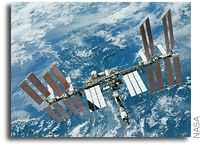NASA International Space Station Research Highlights Dec. 6 2010

Scott Kelly completed his 36th Psychomotor Vigilance Self Test (Reaction Self Test) run out of 115 runs. The experiment is a portable five-minute reaction time task that allows crew members to monitor the daily effects of fatigue on performance while aboard the station.
Device for the study of Critical Liquids and Crystallization — Directional Solidification Insert C (DECLIC-DSI-C) has completed the second of four runs. During two solidification runs at very low speeds, two types of exotic cellular patterns became evident. DECLIC-DSI-C provides a better understanding of the relationship between micro- and macrostructure formation during solidification processes. The experiment ultimately could result in new and better materials for use in manufacturing on Earth.
Scott Kelly performed a run of Capillary Flow Experiment-2 (CFE-2) the experiment with great success. Previous tests documented all of the critical wetting and de-wetting angles of the vessel to within 2 to 3 degrees of the principal investigator’s numerical model predictions. This run narrowed down the critical angles in both the clockwise and counterclockwise direction and identified all six critical angles previously left unknown. CFE investigates the role of capillary forces in the transport and storage of fluid systems in space. Such systems are crucial to developing safe, reliable, and affordable spacecraft to expand exploration of our solar system and universe.
Twenty of 24 runs of the Japan Aerospace Exploration Agency-sponsored Chaos, Turbulence and its Transition Process in Marangoni Convection (Marangoni) have been completed. This physics experiment analyzes the behavior of a surface-tension-driven flow in microgravity. The experiment could help improve cooling for personal computers and energy transportation in the future.
Jorge Sotomayor, Lead Increment Scientist
Expedition 25/26








